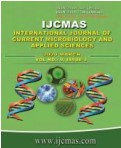


 National Academy of Agricultural Sciences (NAAS)
National Academy of Agricultural Sciences (NAAS)

|
PRINT ISSN : 2319-7692
Online ISSN : 2319-7706 Issues : 12 per year Publisher : Excellent Publishers Email : editorijcmas@gmail.com / submit@ijcmas.com Editor-in-chief: Dr.M.Prakash Index Copernicus ICV 2018: 95.39 NAAS RATING 2020: 5.38 |
A field experiment was conducted at KVK, Kalburgi, on black soils. The zero tillage practices were followed since 3 years in five main plots and different reduced nutrient levels were imposed as subplots, by following split plot design. Every year same crop pigeonpea genotype TS-3R was grown. The prophylactic measures were undertaken against pests and diseases. Biological observations were analysed at 50 per cent flowering. Results of experiment shows that higher seed yield, stalk yield, SPAD values and sustainable yield index were observed in zero till-raised bed with residues retention along with application of 100 per cent recommended dose of inorganic fertilizer compared to other combinations. Higher nodules, nodule weight, Arbuscular mycorrhizal fungi (AMF) root colonization, enzymatic activities and population of microbial enumeration were observed in zero tillage raised bed with residues retention and lowest was found in conventional tillage practices, Significantly higher microbial properties, nodule number and weight were recorded with the treatment received no fertilizer and decreased with increase in the dose of inorganic fertilizer and lowest number was found in 100 per cent recommended inorganic fertilizers. Looking to yield levels in zero tillage practices and higher microbial properties in zero fertilizer, it can be concluded that sustainable yield were observed in reduced dose of nutrient in zero tillage practices, there, by saving of 50 per cent nutrient requirement in long term zero tillage practices.
 |
 |
 |
 |
 |